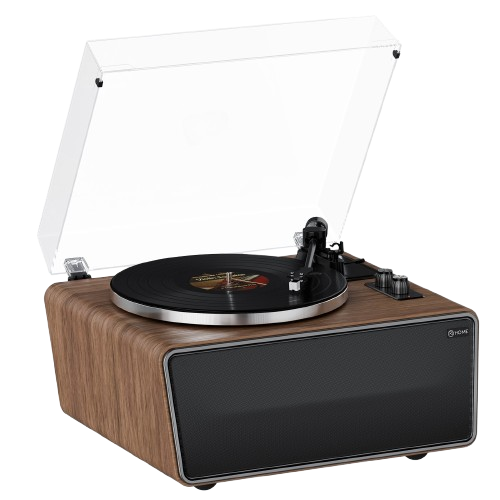Alright, fellow music lovers, let's talk about one of the most crucial, yet often misunderstood, adjustments on your turntable: the counterweight. Specifically, how to set it correctly on your XJ-HOME turntable. Getting this right is absolutely fundamental to achieving that glorious sound your vinyl is capable of and ensuring the longevity of both your records and your stylus.
Now, I know what some of you might be thinking. "Counterweights? Tracking force? Sounds complicated!" And yes, the audiophile world can sometimes make simple things sound like rocket science. But here’s the truth, especially when dealing with a thoughtfully designed system like those from XJ-HOME: this is a straightforward process. It's more about careful attention than arcane knowledge. Our philosophy at https://xenonjade.com is about making high-quality audio accessible, and that includes empowering you to get the best from your gear without needing an engineering degree.
So, let's demystify Vertical Tracking Force (VTF) and get your tonearm perfectly balanced.
Why Bother? The Magic of Correct Tracking Force
Before we dive into the "how," let's briefly touch on the "why." The counterweight allows you to set the correct downward pressure of the stylus in the record groove – this is your VTF.
-
Too little force: The stylus will bounce around in the groove, leading to skipping, distortion (especially on louder passages or sibilant vocals), and poor bass response. It can actually cause more damage to your records than slightly too much force, as the stylus mistracks and gouges the groove walls.
-
Too much force: The sound can become dull and lifeless, detail gets squashed, and you'll accelerate wear on both your stylus and your records.
The goal is to find that "Goldilocks zone" – just the right amount of pressure for the stylus to securely trace the groove modulations, extracting all that lovely musical information.
What You'll Need:
-
Your XJ-HOME Turntable
-
Steady hands and a bit of patience
-
(Optional, but Recommended for Precision): A Stylus Force Gauge. While you can get very close by following the steps below, a good digital stylus gauge is an affordable tool that takes the guesswork out of the final setting. You can find many good explanations on their use and importance on sites like Vinyl Me, Please's blog which often has helpful tips for vinyl enthusiasts.
The Simple Steps to Perfect Balance:
Important Note: Your XJ-HOME turntable or cartridge manual will specify the recommended tracking force for your particular stylus. Always refer to this figure. If you can't find it, a general range for many moving magnet cartridges is 1.5 to 2.5 grams, but this is a ballpark – precision is key.
-
Preparation is Key:
-
Ensure your turntable is on a stable, perfectly level surface. This is crucial for accurate tonearm balancing.
-
Remove any stylus guard.
-
Make sure the anti-skate control (if your XJ-HOME model has an adjustable one) is set to zero or its minimum setting for now. We'll come back to this later if needed, but it can interfere with achieving a true zero balance.
-
-
Achieve "Zero Balance" (Floating the Tonearm):
-
Carefully unclip the tonearm from its rest and hold it securely.
-
Rotate the main counterweight at the back of the tonearm. If you turn it towards the front of the turntable, the stylus end will get heavier. If you turn it towards the back, the stylus end will get lighter.
-
Your goal is to adjust the counterweight until the tonearm floats perfectly parallel to the record platter, like a seesaw in perfect equilibrium. It shouldn't dip down at the stylus end, nor should it fly up.
-
This takes small, gentle adjustments. Be patient. The tonearm should hover effortlessly. This is "zero grams" of tracking force.
-
-
Set Your Tracking Force Dial to Zero:
-
Most counterweights have a numbered dial on the front. Once you've achieved that perfect "zero balance" from Step 2, hold the main counterweight itself steady so it doesn't rotate, and then carefully turn only the numbered dial until the "0" lines up with the indicator mark on the top of the tonearm.
-
You've now calibrated your dial to your tonearm's zero balance point.
-
-
Apply the Recommended Tracking Force:
-
Now, rotate the entire counterweight assembly (the weight and the dial together) counter-clockwise (towards the front of the turntable).
-
Turn it until the number on the dial corresponding to your stylus's recommended tracking force (e.g., "1.8" if the recommendation is 1.8 grams) lines up with the indicator mark on the tonearm.
-
You are now applying the specified downward pressure.
-
-
Setting Anti-Skate (If Applicable):
-
Anti-skate counteracts the natural tendency of the tonearm to want to pull towards the center of the record. A good starting point is to set the anti-skate dial to the same value as your tracking force (e.g., if VTF is 1.8 grams, set anti-skate to 1.8).
-
Fine-tuning anti-skate can be done by ear or with a test record, but matching it to the VTF is a common and usually effective practice.
-
Fine-Tuning by Ear (The Art Part)
Even with a gauge, your ears are the final arbiters. Listen critically to a familiar record.
-
Sounding thin, sibilant, or prone to mistracking on loud passages? You might need a touch more tracking force (try increasing in 0.1-gram increments, but don't exceed the cartridge manufacturer's maximum).
-
Sounding heavy, dull, or lacking in high-frequency detail? You might have too much. Try decreasing slightly.
The aim is clear, focused sound across the frequency spectrum, with secure tracking.
The XJ-HOME Advantage
With an XJ-HOME turntable, you've chosen a piece of equipment where user experience and quality sound reproduction are paramount. The tonearms are designed for straightforward adjustment, allowing you to perform this critical setup with confidence. We believe that enjoying vinyl shouldn't be an exercise in frustration.
Conclusion: Unlock Your System's Potential
Taking a few minutes to correctly set your counterweight and tracking force is one of the most impactful things you can do for your listening pleasure and the health of your vinyl collection. It’s a simple process that pays huge sonic dividends.
So, embrace the ritual, trust your ears (and your XJ-HOME manual!), and get that tracking force dialed in. The music will thank you for it. Happy listening!





Leave a comment
All comments are moderated before being published.
This site is protected by hCaptcha and the hCaptcha Privacy Policy and Terms of Service apply.